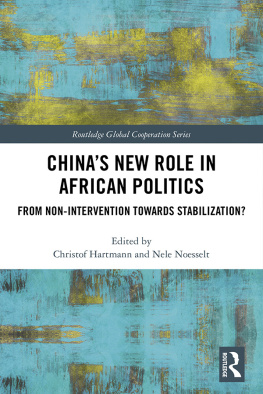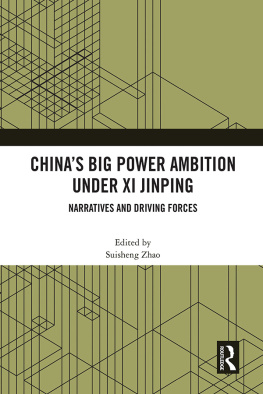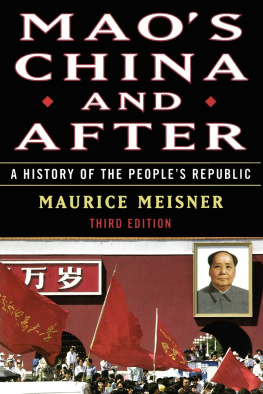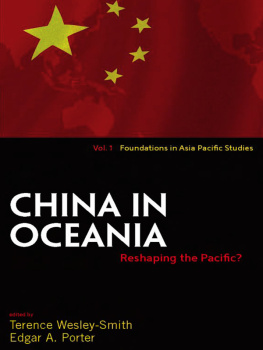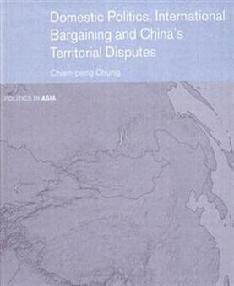Stanford University Press
Stanford, California
2017 by the Board of Trustees of the Leland Stanford Junior University. All rights reserved.
No part of this book may be reproduced or transmitted in any form or by any means, electronic or mechanical, including photocopying and recording, or in any information storage or retrieval system without the prior written permission of Stanford University Press.
Printed in the United States of America on acid-free, archival-quality paper
Library of Congress Cataloging-in-Publication Data
Names: Fingar, Thomas, editor.
Title: Uneasy partnerships : Chinas engagement with Japan, the Koreas, and Russia in the era of reform / edited by Thomas Fingar.
Other titles: Studies of the Walter H. Shorenstein Asia-Pacific Research Center.
Description: Stanford, California : Stanford University Press, 2017. | Series: Studies of the Walter H. Shorenstein Asia-Pacific Research Center | Includes bibliographical references and index.
Identifiers: LCCN 2016043165 (print) | LCCN 2016044486 (ebook) | ISBN 9781503601413 (cloth : alk. paper) | ISBN 9781503601963 (pbk. : alk. paper) | ISBN 9781503601970 (ebook) | ISBN 9781503601970 (ebook)
Subjects: LCSH: ChinaForeign relations1976 | ChinaForeign relationsJapan. | JapanForeign relationsChina. | ChinaForeign relationsKorea. | KoreaForeign relationsChina. | ChinaForeign relationsRussia (Federation) | Russia (Federation)Foreign relationsChina.
Classification: LCC DS779.27 .U63 2017 (print) | LCC DS779.27 (ebook) | DDC 327.51dc23
LC record available at https://lccn.loc.gov/2016043165
Typeset by Newgen in 11/14 Garamond
Uneasy Partnerships
CHINAS ENGAGEMENT WITH JAPAN, THE KOREAS, AND RUSSIA IN THE ERA OF REFORM
Edited by Thomas Fingar
Stanford University Press
Stanford, California
THE WALTER H. SHORENSTEIN
ASIA-PACIFIC RESEARCH CENTER
Studies of the Walter H. Shorenstein Asia-Pacific Research Center
Andrew G. Walder, General Editor
The Walter H. Shorenstein Asia-Pacific Research Center in the Freeman Spogli Institute for International Studies at Stanford University sponsors interdisciplinary research on the politics, economies, and societies of contemporary Asia. This monograph series features academic and policy-oriented research by Stanford faculty and other scholars associated with the Center.
Contents
Thomas Fingar
Thomas Fingar
Liru Cui
Suisheng Zhao
Seiichiro Takagi
Thomas Fingar
Myung-Hwan Yu
Thomas Fingar and David Straub
Artyom Lukin
Thomas Fingar
Preface
When everything comes together, the challenges of producing an edited volume are more than compensated for by the increased understanding of complex problems that results from interaction among the contributors and insights that emerge from the juxtaposition of independently authored analyses. Most of the patterns and trends that become apparent when comparing and aggregating the interpretations in this volume were not anticipated when we began this project in 2012 or predicted by any of the participants when we discussed alternative ways to explore and explain interactions among China and the countries of Northeast Asia. The decision to focus on specific dyads and multistate groupings without attempting to fit the analysis to a predetermined framework, model, or theory proved fruitful. We all learned new and important things about Chinas engagement and about changes within the countries of Northeast Asia. I hopeand expectthat our readers will also discover new insights and deepen their understanding of Chinas perceptions, priorities, and policies and that they will gain similar insight into the ways in which regional states responded to perceived opportunities and risks resulting from Chinas rise and greater activism on the regional stage.
As director of the Shorenstein Asia-Pacific Research Center, I am pleased that the center was able to support the project and proud to include this volume in our series published by Stanford University Press. It is the second in a planned series that will examine Chinas interactions with other regions of the world and, we hope, reveal additional trends and patterns transcending individual regions and strengthen confidence in our judgments about how and why those patterns exist. Neither this volume nor others in the series attempt to predict the future, but the identification of trends, what drives them, and their implications for the countries involved provide a useful starting point for anticipating how events may unfold.
Tom Fingars acknowledgment section properly cites the contributions of the many people who helped transform an interesting idea into a scholarly contribution to our understanding of Chinas objectives, how other countries perceive them, and how Chinas increased engagement with other parts of the world is changing both regional and global interactions. Many people contributed, but the genesis of the project was his observation, based on decades of experience as a State Department and intelligence community analyst, that all nations formulate foreign policy goals and strategies on the basis of their perception of perils and opportunities and that no nation ever achieves all that it hopes to achieve in the international arena.
What actually happens, he observed, almost always results from the interaction of multiple actors pursuing independent agendas with varying amounts of skill and resources. Chinas rise, he argued, makes it a more formidable player, but China does not and cannot have the ability to ignore the actions and aspirations of prospective partners and interested third parties. He translated this insight into a proposal and the proposal into a plan. His observation and argument made sense but remained to be subjected to rigorous empirical analysis. My Shorenstein APARC colleagues and I decided to fund the project because it appeared both possible and important to learn whether, or to what extent, his observations were correct and to discover the most important directions and drivers of Chinas global engagement. This book more than justifies the confidence we had in both Fingar and the project. More important, its publication makes the research of the contributors and the insights from the project available to students, scholars, and government officials seeking to understand and to influence developments in the global arena.
Gi-Wook Shin
Director
Walter H. Shorenstein Asia-Pacific Research Center
Acknowledgments
This volume, like all successful endeavors, has many parents. Each contributed in a unique way, but all contributions were essential. No individual scholar could have produced the insightful analyses of so many and so diverse dyadic and multiparty interactions, and any attempt to identify and explain spatial and temporal patterns, trends, and linkages would perforce be severely limited without high-quality case studies. This was a team effort, and I acknowledge, albeit inadequately, the important contributions of each member of the team.
The genesis of the project was an invitation from the Shorenstein Asia-Pacific Research Centers (APARC) director, Gi-Wook Shin, to propose new ways to examine changing relationships in Asia and between Asian countries and other portions of the globe. His invitation spurred me to write down a number of observations about Chinas increasing engagement with other regions, dissatisfaction with existing explanations of what was happening and where it was headed, and an initial list of questions for empirical research. Over the following few months, Gi-Wook, Shorenstein APARC associate director for research Dan Sneider, and APARC colleagues Mike Armacost, David Straub, Karl Eikenberry, Harry Rowen, and Don Emmerson critiqued and commented on successive drafts with the shared goal of developing a research strategy that, if successful, would significantly enhance our understanding of Chinas role and limitations in the global order. I am deeply grateful for their insights, suggestions, and frank and sincere criticism.




